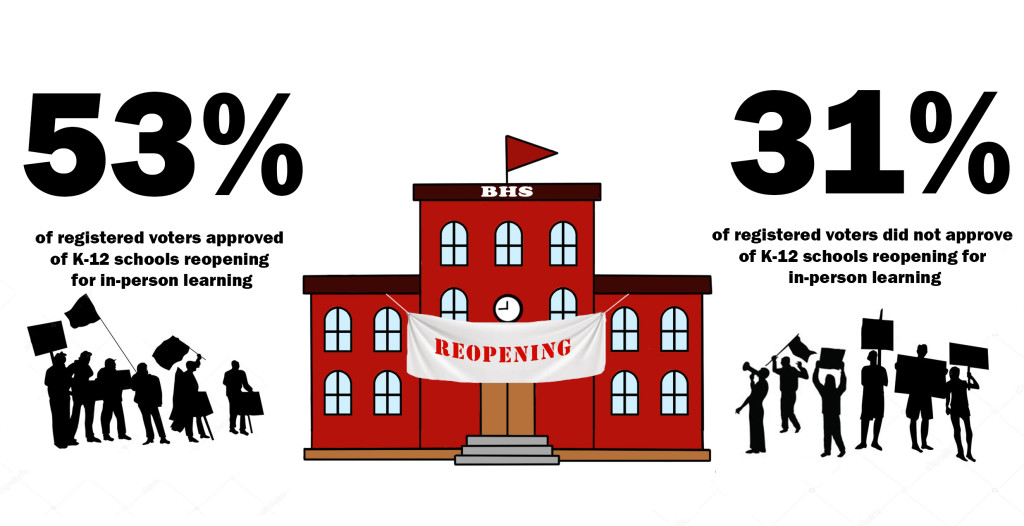After months of back and forth, the Berkeley Unified School District (BUSD) announced it had reached a tentative agreement with the Berkeley Federation of Teachers (BFT) for a hybrid reopening of all schools, grades K-12, on February 17. Shortly after the announcement, on March 12, the school board expanded their proposal, providing elementary-aged students with five days of in-person learning. The move has done little to cool the debate over reopening, as advocates for more in-person class time and those concerned about the safety and logistical feasibility of in-person learning share their opinions.
Since October, one group in particular — BUSD Parents — has dominated the conversation on the side of reopening. Holding marches and rallies, and showing up to school board meetings, the group's slogan is, “No distance learning, no hybrid, just five full days.” Yet Mati Teiblum, one of the members of BUSD Parents, said the slogan is only a starting point.
“While we can march and say five full days now, I’m realistic,” said Teiblum, who is the parent of Berkeley High School (BHS) students. Teiblum contemplated four full days with 90% capacity, saying the important thing is that the district errs on the side of the action.
A spokesperson for BUSD, Trish McDermott, agreed with that sentiment. “Our goal is to return our schools to full-time, in-person learning for all students when pandemic conditions and risk mitigation practices allow for that,” said McDermott. Berkeley is currently in the orange tier which, under state and local guidelines, means middle and high schools are allowed to reopen.
But for Mara Kolesas, a member of BUSD Parents leadership group and the parent of elementary-aged students, nothing short of five full days for students of all ages as soon as possible is sufficient. She pointed to research that shows schools can open safely without community transmission and an op-ed in Spanish that demonstrates the inequities of distance learning across socio-economic lines.
Le’Onnyi Buckley, a member of the BHS Black Student Union, also stressed the inequities of distance learning. For her, however, an ideal learning situation included an off-campus location for students to access high-speed internet and better technology for students with complicated or crowded living spaces.
While distance learning has been shown to produce inequities, some point to reopening of schools during COVID as a process to further drive that imbalance. Transportation to school, for students who used public or school provided transportation pre-pandemic, can be an insurmountable barrier. This may be just part of the reason that Black and Latino parents showed greater hesitancy to send their children to school when other districts re-opened.
All people interviewed agreed that students should have a voice in deciding the pace of school reopening. While still asserting that teacher’s unions had the right to collective bargaining, according to Teiblum and Kolesas, students had been left out of considerations of reopening by the school board and teacher’s unions.

Acknowledging the complexity of the situation, Kolesas stated, “None of the established actors — and that involves the district, the board, the PTA council, and the City of Berkeley in its three components: manager, city council, and mayor — none of the public entities who are supposed to represent the wellbeing of the kids spoke in favor of the kids.” (However, Kolesas made an exception for one school board member: Laura Babbitt.)
McDermott, the district spokesperson, said that their plans for reopening included “partnership with our families and staff.”
On how to fix the perceived disconnect between the interests of the school board, the teacher’s union and the interest of students, Teiblum and Kolesas differed again. In efforts to pressure the entities, members of the community have taken unconventional actions like calling for the recall of board members who had opposed reopening, and filming the union president dropping his child off at a private, in-person pre-school while public schools remained closed.
Teiblum supported recalling board members, saying the process was for when voters felt the politician had “failed to uphold the duties of their office,” and which he believed described board members who didn’t put enough effort into reopening. Teiblum holds a moderate opinion on filming the president of the teachers union. He said the president of the union’s public stance that defended not going back to school because young kids couldn’t wear masks made the “dramatic outrage” over filming the president overdone.
Kolesas was more hesitant. She questioned the efficacy of recalling the board in such a short period of time and strongly opposed “mixing the personal and the political” in the case of filming the teacher’s union president.
Regardless of the methodology used to change the course of action of the district, Kolesas and Teiblum remained adamant that the proposed hybrid model was insufficient.
“A school [that is] open four hours a week isn't an open school,” said Kolesas, quoting Shamik Dasgupta, a fellow BUSD parent. “It’s a closed school with a cherry on top.”





